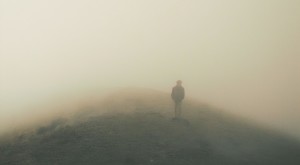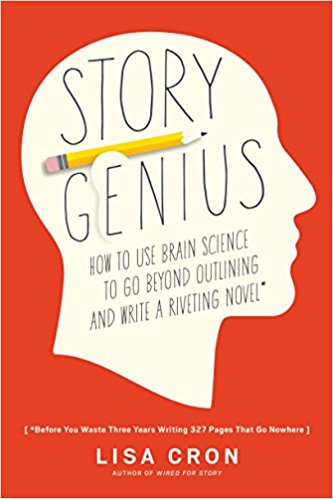
by Sandra Gulland | Dec 16, 2017 | Adventures of a Writing Life |
Every stage of writing a book is a challenge—the beginning, the middle, and the end—but I think figuring out how to begin to write a book might be the most difficult.
I’m at the beginning stage of writing my next novel now. I’m going to use Scrivener for this one, and so I have a lot to learn. It’s coming.
I’ve started etching out a plot using plot “beats” I’ve gleaned from Blake Snyder’s Save the Cat.

Yet I’ve been floundering. I’m accustomed to writing biographical fiction, with reams of biographies to work from. That has its own challenges, certainly, but for me, the free fall of a novel based on someone about whom there are only a few paragraphs written—and whose existence is debated, at that—is even more challenging.
I’ve discovered a book that is excellent for the pre-plot stage: Story Genius: How to Use Brain Science to Go Beyond Outlining and Write a Riveting Novel (Before You Waste Three Years Writing 327 Pages That Go Nowhere).
I’ve resisted this book because it felt too gimmicky, but it was recommended by writers I respect and admire, and so I’m giving it a try. I’m impressed! It’s helping me to closely define my protagonist before I construct the plot. It doesn’t make it easy (nothing can), but it’s highly worthwhile. If you are at the pre-plot stage—or if you are having difficulty knowing how to begin writing—I recommend you read this book. Better yet, do the exercises.
How do you begin writing a book? What works for you?
SaveSave
SaveSave
SaveSave
SaveSave
SaveSave
SaveSave
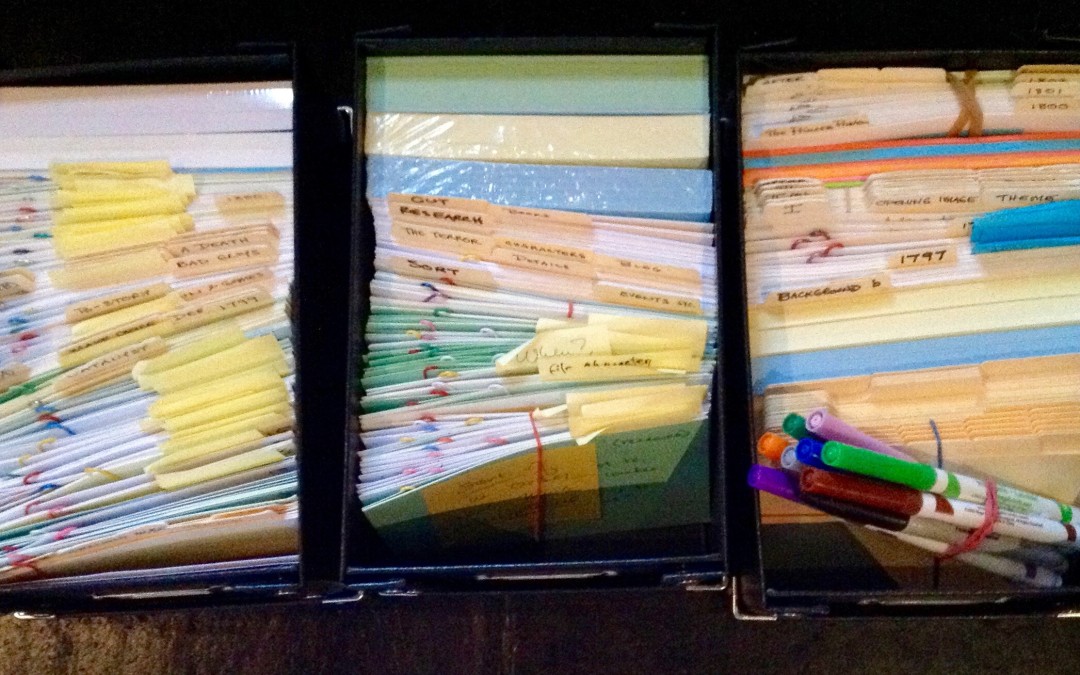
by Sandra Gulland | Jan 4, 2016 | Adventures of a Writing Life, On Plot, The Game of Hope, The Writing Process |
I’ve been flailing, I confess: in Excel plot worksheets, in piles of plot index cards, in Word files summarizing my plot (or trying to), in books on plot, in on-line courses and YouTube videos on plot!

I saw all this as a sign of a project in trouble. I simply couldn’t figure it out! It occurred to me that I was “finished” — but not in a good way.

So last night I was reassured reading A Technique for Producing Ideas by James Webb Young. It turns out that my piles—and piles—of index cards are not a mistake.
I turns out that my Lost-in-the-Very-Deep-Dark-Woods state of mind is simply Stage Two of the Creative Process.
A Technique for Producing Ideas is a slender little book, a classic for marketers … but the wisdom in it applies to any creative endeavour.
For example:
The first [step in producing ideas] is … to gather raw material.
So: all my frenetic searching was not a waste of time? So: my impulse to know everything possible about my subject is not procrastination?
… it you have any sizable job of specific material gathering to do it is useful to learn the card-index method of doing it.
Ah ha!
You take one fact [on an index card], turn it this way and that, look at it in different lights, and feel for the meaning of it. … You bring two facts together and see how they fit … like a jig-saw puzzle.
I especially his description of the “searching” stage of the creative process:
… it is almost like listening for the meaning instead of looking for it.
And, he adds:
When creative people are in this stage of the process they get their reputation for absentmindedness.
So very true.
First, little tentative or partial ideas will come to you. Put these down on paper. Never mind how crazy or incomplete they seem: get them down. These are foreshadowings of the real idea that is to come, and expressing these in words forwards the process. Here again the little 3 × 5 cards are useful.
The second thing that will happen is that, by and by, you will get very tired of trying to fit your puzzle together.
Tell me about it!
Let me beg of you not to get tired too soon. The mind, too, has a second wind. … Keep trying to get one or more partial thoughts onto your little cards.
after a while you will reach the hopeless stage.
Can he read my mind?
Everything is a jumble in your mind, with no clear insight anywhere.
He can!
When you reach this point, … then the second stage … is completed, and you are ready for the third one.
So: Stage One is information gathering (check), and Stage Two is hopelessness (check). What could possibly be next?
In this third stage … you drop the whole subject and put the problem out of your mind as completely as you can. … Listen to music, go to the theater or movies, read poetry or a detective story.
Binge watch Making a Murderer? Going to the beach? All this is not procrastination, avoidance? So all this is Stage Three?
Indeed it is. So what’s Stage Four?
In the first stage you have gathered your food. In the second you have masticated it well. Now the digestive process is on. Let it alone. … if you have really done your part in these three stages of the process you will almost surely experience the fourth.
Which will be?
Out of nowhere the Idea will appear.
Perhaps not surprisingly, reading this slender little tomb, I began to get a rush of ideas … which I quickly scribbled onto index cards.
This is the way ideas come: after you have stopped straining for them and have passed through a period of rest and relaxation from the search.
There is, of course, a final step—Stage Five—and that’s taking “your little newborn idea out into the world of reality.” (I.e.: trying to work it into the complex fabric of the manuscript.)
Do not make the mistake of holding your idea close to your chest at this stage. Submit it to the criticism of the judicious. When you do, a surprising thing will happen. You will find that a good idea has, as it were, self-expanding qualities. … Thus possibilities in it which you have overlooked will come to light.
And so, feeling inspired, ideas popping, I look forward to our two weeks at the beach as Stage Four.
Happy New Year!
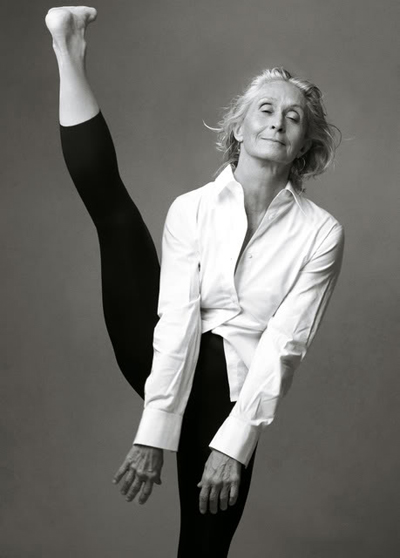
by Sandra Gulland | Nov 22, 2015 | Adventures of a Writing Life |
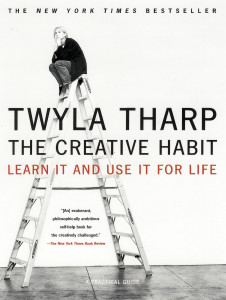
I’ve been recently inspired by Twyla Tharp’s book THE CREATIVE HABIT: LEARN IT AND USE IT FOR LIFE.
Here are some quotes:
Some people find … the moment before creativity begins … so painful that they simply cannot deal with it. They get up and walk away from the computer, the canvas, the keyboard; they take a nap or go shopping or fix lunch or do chores around the house. They procrastinate. In its most extreme form, this terror totally paralyzes people.
After so many years, I’ve learned that being creative is a full-time job with its own daily patterns. That’s why writers, for example, like to establish routines for themselves. The most productive ones get started early in the morning, when the world is quiet, the phones aren’t ringing, and their minds are rested, alert, and not yet polluted by other people’s words. They might set a goal for themselves—write fifteen hundred words, or stay at their desk until noon—but the real secret is that they do this every day. In other words, they are disciplined. Over time, as the daily routines become second nature, discipline morphs into habit.
I know this works, I know this is true: I preach it, yet I don’t always succeed in doing it. Today is an example. I frittered away the morning hours answering emails that I told myself were urgent … but, frankly, anything can wait a few hours.
So: it was just an excuse.
The routine is as much a part of the creative process as the lightning bolt of inspiration, maybe more. And this routine is available to everyone. Creativity is a habit, and the best creativity is a result of good work habits.
Yes, I’m shouting these words! At myself as much as to all of you.
Here are some more delicious quotes:
In order to be creative you have to know how to prepare to be creative …
there’s a process that generates creativity—and you can learn it. And you can make it habitual.
It takes skill to bring something you’ve imagined into the world: to use words to create believable lives, to select the colors and textures of paint to represent a haystack at sunset, to combine ingredients to make a flavorful dish. No one is born with that skill. It is developed through exercise, through repetition, through a blend of learning and reflection that’s both painstaking and rewarding. And it takes time.
If art is the bridge between what you see in your mind and what the world sees, then skill is how you build that bridge.
That’s the reason for the exercises. They will help you develop skill. Some might seem simple. Do them anyway—you can never spend enough time on the basics.
Everything is raw material. Everything is relevant. Everything is usable. Everything feeds into … creativity. Without the time and effort invested in getting ready to create, you can be hit by the thunderbolt and it’ll just leave you stunned.
It’s vital to establish some rituals—automatic but decisive patterns of behaviour—at the beginning of the creative process, when you are most at peril of turning back, chickening out, giving up, or going the wrong way.
Read
this blog post for more quotes and an example of one of the creativity exercises Tharp gives in this book. Always carry a pencil is one. :-)
Who is Twyla Tharp?
Among many other things,
Twyla Tharp is an artist, choreographer, and creator of the smash-hit Broadway show,
Movin’ Out. She has created 130 dances for her company, the Joffrey Ballet, the New York City Ballet, Paris Opera Ballet, London’s Royal Ballet, and American Ballet Theatre. She is 74 now, and far from slowing down:
Choreographer Twyla Tharp brings two bold new works to Kennedy Centre — an interview in
The Washington Post. My hero!
A few great links to share
• Masters of the Everyday: Dutch Artists in the Age of Vermeer. Be sure to click through the individual paintings and read the explanations. It’s wonderful how you can zoom in for a close look. I especially liked “The listening Housewife.” For a review of this exhibit, read this post.
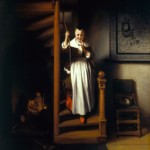
• Why Your Critics Aren’t The Ones Who Count, an inspiring— and funny—Ted-type talk by Brené Brown.
What I’m up to
I’m having a hard time with the revision of Moonsick. I keep stirring the pot, but it’s slow to thicken. This beautiful photo of “Man in a fog” by Harman Wardani feels perfectly expressive of my state of mind.
Reading Tharp’s book, I realized that I have a ritual that triggers creativity: I record the day’s writing goals in a notebook and — bam! — I’m off to the races.
You may have noticed that my website is being revised (so that it will be visible on all devices). It’s still in the construction phase, so please bear with us.
The world news continues to be both distracting and extremely distressing. This cartoon, which I posted to FaceBook, has been getting a lot of “likes,” so I gather most everyone feels the same:
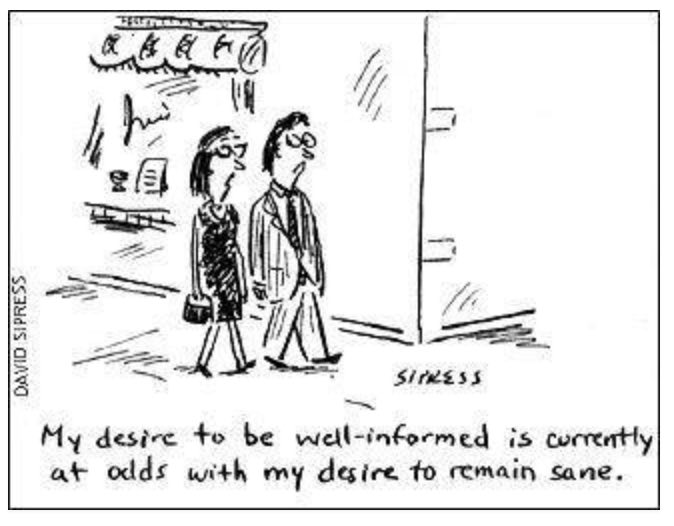
Have a good week … . Stay sane!

by Sandra Gulland | Apr 8, 2015 | Adventures of a Writing Life, Resources, Resources for Writers, The Writing Process |
I begin a novel by writing a plot. This doesn’t mean listing actions, but tracing the characters emotional arcs as well. The two are intertwined.
I don’t go into detail: I simply describe a scene in a sentence or two. Even so, it comes to 40 pages, and I take it through several drafts.
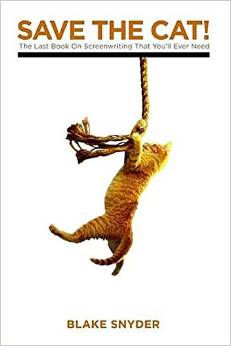
Save the Cat: a great book on plot
I basically use the guidelines Blake Snyder sets out in Save the Cat: they are simple and straightforward.
I’ve condensed them into a “Beat Sheet Guide” for my own use (click to download), but I highly recommend reading the book. Snyder is funny and to-the-point.
I write the first draft quickly, more or less following the scene-by-scene outline I’ve laid out according to these “beats.”
However, somewhere between the first draft and the last (ninth? tenth?), I find I need to regroup. That is: I need to have another look at the structure of the novel—the bones of it.
The (dreaded) middle of the writing process
This is where I am now, struggling to find firm ground in the “swamp” of the fifth draft of my current WIP, The Game of Hope, working title of the first of my Young Adult novels about Hortense.
Many things change in the process of writing. Themes emerge, characters step into the foreground and other characters prove to be ineffectual and need to be cut. New scenes are required, entire chapters.
It’s a confusing stage of the writing process: taking a novel apart and trying to put it back together again. It’s easy to get lost. For me, this is when I begin to lose faith—in myself as a writer, and in the novel. This is when I lose heart.
This is also when I become a magnet for solution.
A few weeks back I happened upon Shawn Coyne’s blog series: The Story Grid. (Soon to come to a bookstore near you.) I’ve been gobbling up the blog posts and making notes. Here are some “plot” visuals from the Resources page of this website.
This first visual is on genre: what genre is your story? (The visual is a bit hard to understand unless you’ve read what he’s had to say.)
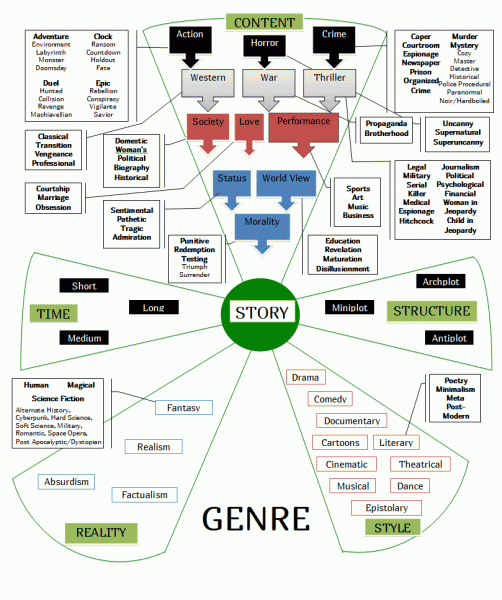
One of the most interesting aspect of Coyne’s analysis, for me, is breaking story structure down into three types: archplot (the standard), miniplot (mostly literary), and antiplot (experimental).
Having been a fan of Joseph Campbell’s Hero with a Thousand Faces since I was 16 — a very long time ago — , I assumed that archplot was really the only structure. But try to analyze an Alice Monroe story in this way! It simply doesn’t work. Her stories follow Coyne’s miniplot model. This makes sense.
Too, I’ve sometimes wondered if the archplot “quest” story model wasn’t basically male, wondered if there was a female alternative. (A thought to tuck away for future pondering.)
I’ve an important thing to decide about the novel I’m writing: What genre is it? It’s a coming-0f-age novel, true, but it’s also a romance. As such, it’s missing some key scenes — which helps explain what my editors have been saying.
I’ll be writing more on The Story Grid in follow-up posts, but for now, it’s time to crawl back into that swamp (the WIP).

by Sandra Gulland | Jan 23, 2015 | Adventures of a Writing Life, On Research, Resources, Resources for Writers, The Writing Process |
My husband and I have been staying in one of our favourite spots, a Solecito casita on beautiful Playa Blanca on the Mexican Pacific coast. (Our casita: the one shown above.)
It’s a totally relaxing time for us, and—surprisingly—one of the pleasures, for me, is that I get quite a bit done:
• I edited the 4th draft of The Game of Hope and began draft 5.
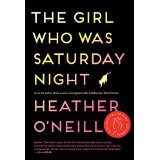
• I read a lot, likely because I’m reading on my little Kindle, and not on the Kindle app on my Net-connected iPad.
• I finished THE BOOK OF STRANGE NEW THINGS by Michel Faber (my first Sci-Fi), and am close to finishing THE GIRL WHO WAS SATURDAY NIGHT by Heather O’Neill. (Delightful! I have previously read and very much enjoyed LULLABIES FOR LITTLE CRIMINALS.) I’m still reading and highly recommend Publishing 101 by Jane Friedman as well as various research books.
• I read a pdf of wonderful novel that I gave a rave quote for … I’ll have more to say on this book when it is published in March.

• I listened to a wonderful audible recording of ALL THE LIGHT YOU CANNOT SEE, a novel by Anthony Doerr that was on virtually every “best of 2014” book list.
Coursera.org: How to Learn
I caught up on the video lectures of a Coursera course I’m taking on how to learn. (You can watch them here.)
Why am I following this course? Because I am determined to become more conversant in both French and Spanish. (In fact, as I go for my daily walk on the beach, I listen to French tapes.)
My research method
This course has got me reconsidering my writing research method. I used to write notes out by hand. Now I prefer highlighting passages on Kindle and sending these to Evernote—knowing that I can always find the information should I need it.
Effortless! Right?
Not exactly. Evernote is great, but the trouble is: when I look for something on Evernote, I find the mass of notes overwhelming. It’s not that functional system for me, in truth, and I’ve long had a hunch that writing down notes by hand was more effective. This Coursera course has confirmed the importance of approaching information through different media.
Another problem I have is resistance to organizing my research. I’m content to cruse the Net, buy new books, read and highlight them, but I’m somewhat scattered and slapdash about it, in truth.
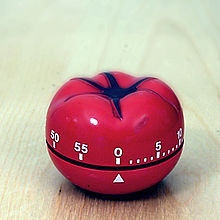
This course has reminded me of the value of the Pomodoro approach: setting a timer for 25 minutes of focussed distraction-free (i.e. Net-free) period of time.
It has also reminded me of the key importance of review: and this is where note-taking comes in.
The course also emphasises how important relaxation is to learning. And so … to the hammock.











